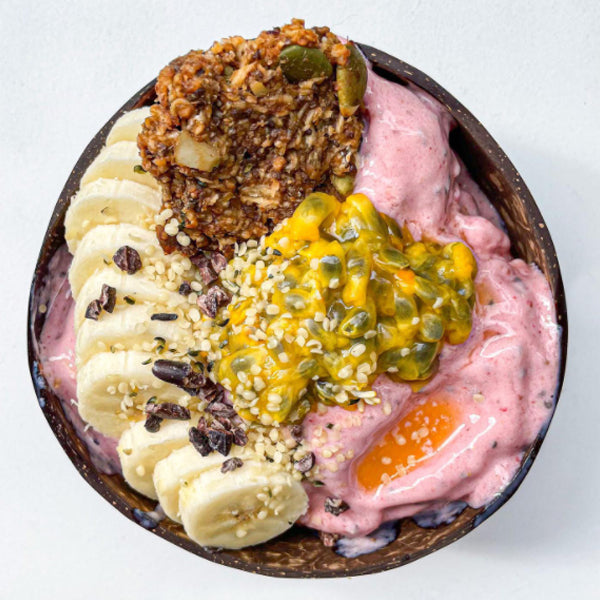
In recent years, the wellness world has witnessed the meteoric rise of smoothie bowls as a trendy and photogenic breakfast option.
These vibrant and colourful concoctions are splashed across social media feeds, enticing us with their artistic arrangements of fruits, nuts, and seeds. But beyond their aesthetic appeal, are smoothie bowls truly as healthy as they seem, or is there more to the story?
Let's delve into the world of smoothie bowls, separating fact from fiction to determine whether they truly live up to their health-conscious reputation.
The Pros:
-
Nutrient-Rich: Smoothie bowls often feature a medley of nutrient-dense ingredients such as fruits, vegetables, and nuts. These ingredients are packed with essential vitamins, minerals, and antioxidants that contribute to overall well-being.
-
Hydration Boost: Many smoothie bowl recipes incorporate a liquid base like coconut water or almond milk, helping to keep you hydrated, especially when made with water-rich fruits like berries and watermelon.
-
Customizable: The beauty of smoothie bowls lies in their versatility. You can tailor them to your dietary preferences, incorporating plant-based proteins, healthy fats, and fiber for a well-rounded meal.
-
Satiety Factor: The thickness of smoothie bowls, often achieved by using frozen fruits or ice, can create a sense of fullness that lasts longer than a regular liquid smoothie.
The Cons:
-
Caloric Intake: While smoothie bowls can be a nutritional powerhouse, they can also be calorically dense. Adding multiple ingredients and toppings might inadvertently lead to excess calorie consumption if portion sizes aren't managed.
-
Added Sweeteners: Some smoothie bowl recipes include sweeteners like honey, agave, or maple syrup. While natural sweeteners have their merits, excessive use can contribute to blood sugar spikes.
-
Topping Overload: The artistic flair of smoothie bowl toppings can inadvertently lead to overindulgence. A sprinkle of nuts, a handful of granola, and a drizzle of nut butter can quickly add up in terms of calories and fats.
-
Nutrient Imbalance: Without careful planning, a smoothie bowl might lack essential macronutrients like protein and healthy fats. Balancing your bowl with ingredients like Greek yogurt, nut butter, or seeds can help address this.
The Verdict:
Like most things in the realm of nutrition, the key to enjoying smoothie bowls is moderation and mindful ingredient choices. When prepared with a focus on balanced nutrition, smoothie bowls can indeed be a healthy addition to your diet. They can provide a convenient way to load up on vitamins, minerals, and fibre, especially if you struggle to consume enough fruits and vegetables in your regular meals.
However, it's crucial to be aware of portion sizes, added sugars, and caloric content. If your smoothie bowl resembles more of a sundae than a nutritious meal, it might be time to revaluate your approach.
In conclusion, smoothie bowls can be a delightful and nutritious addition to your breakfast rotation, as long as they're prepared with a health-conscious mindset. The key lies in crafting a bowl that's not only visually appealing but also thoughtfully balanced in terms of nutrients and calories. So go ahead, embrace the beauty and flavours of smoothie bowls, but remember that the ultimate measure of their healthiness lies in the ingredients you choose and the portions you consume.

